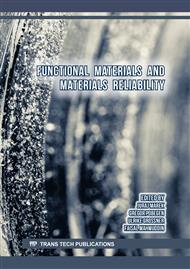[1]
M. Muhajir, M.A. Mizar, and D.A. Sudjimat, Tensile Strength Analysis of Natural Fiber Resin Matrix Composite Materials with Various Layout Variants, Jurnal Teknik Mesin. 24 (2016) 1–8. [in Bahasa]
Google Scholar
[2]
E. Novarini, S.D. Mochammad, The Potency of Ramie Fiber (Boehmeria Nivea S . Gaud ) as a Raw Materials for Textiles, Textile Products and Technical Textile Industries, Arena Tekstil. 30 (2015) 113–122. [in Bahasa]
DOI: 10.31266/at.v30i2.1984
Google Scholar
[3]
Z. Djafar, Jamasri, Rochardjo. S.B. Heru, J.P. Sutapa Gentur, Ramie Woven Reinforced Epoxy Composite (RWREC): Tensile Strength Analysis, International Journal of Engineering and Science Applications (IJEScA). 1 (2014) 55–66.
Google Scholar
[4]
P.I. Purboputro, and A. Hariyanto, Analysis of Tensile and Impact Properties of Ramie Fiber Composites using Alkali Treatment Within 2,4,6 and 8 Hours with Polyester Matrix, Media Mesin: Majalah Teknik Mesin. 18 (2017) 64–75. doi: 10.23917/mesin.v18i2.5238. [in Bahasa]
DOI: 10.23917/mesin.v10i1.3190
Google Scholar
[5]
M.M. Schwartz, Composite Material Handbook. McGraw-Hill., New York, USA, 1984.
Google Scholar
[6]
M.M. Shokrieh, Residual Stresses in Composite Materials, in: Residual Stresses in Composite Materials, Edited by S. Mahmood M. Cambridge,. Woodhead Publishing, 2014.
DOI: 10.1533/9780857098597.1.173
Google Scholar
[7]
Y. Hermawan, The Effect of Spindle Rotation, Feeding Motion and Cutting Depth on Spindle Head Vibration from Drilling Process, Jurnal Rotor. 5 (2012) 18–25.
Google Scholar
[8]
P. Tyczynski, R.E. Sliwa, and R. Ostrowski, Analysis of possibilities for modification of drill bit geometrical parameters used to drill holes in, (2015).
DOI: 10.1108/aeat-06-2014-0094
Google Scholar
[9]
R. Zitoune, Experimental and Numerical Analysis on Drilling of Carbon Fibre Reinforced Plastic and Aluminium Stacks, Composite Structure. (2019).
DOI: 10.1016/j.compstruct.2016.02.084
Google Scholar
[10]
S.M. Bukhari, and M.M. Hussain, Evaluation Of Optimum Process Parameters In Drilling Process Of Hybrid Composites Using Taguchi, International Journal of Mechanical Engineering and Technology (IJMET). 8 (2017) 194–201.
Google Scholar
[11]
C. Li, J. Xu, and M. Chen, Effects of Specialized Drill Bits on Hole Defects of CFRP Laminates, in AIP Conference Preceedings 070017. (2018).
DOI: 10.1063/1.5034913
Google Scholar
[12]
N. Zarif Karimi, H. Heidary, and M. Ahmadi, Residual tensile strength monitoring of drilled composite materials by acoustic emission, Materials and Design. 40 (2012) 229–236.
DOI: 10.1016/j.matdes.2012.03.040
Google Scholar
[13]
S. Chandrabakty, B. Bakri, and Hidayat, Open Hole Tension of Coiranngustifolia Haw Agave Fibers Reinforced Hybrid Composite after Drilling Process, in IOP Conference Series: Earth and Enviromental Science. (2018). doi: 10. 1088/1755-1315/175/1/012002.
DOI: 10.1088/1755-1315/175/1/012002
Google Scholar
[14]
W. Hidayat, Analysis of Tensile Test Strength and Hardness of 2024 Aluminum Welding Results in Tig Welding with Variations 60,70,80A. Universitas Muhammadiyah Yogyakarta: Yogyakarta (2013). [in Bahasa]
Google Scholar
[15]
Chandrabakty, Sri, Optimization of Drilling Process in Ramie Fibre Reinforced Composite, Teknik Mesin, Universitas Hasanuddin: Makassar (2020).
Google Scholar
[16]
Z. Salleh, M.N. Berhan, Mei. Koay Hyiea, Y.M. Taib, A. Kalam, and N.R Nik Roselina, Open hole tensile properties of Kenaf composite and Kenaf/fibreglass hybrid composite laminates, Procedia Engineering. 68 (2013) 399–404.
DOI: 10.1016/j.proeng.2013.12.198
Google Scholar
[17]
R.A Kishore, R. Tiwari, A. Dvivedi, I. Singh, Taguchi analysis of the residual tensile strength after drilling in glass fiber reinforced epoxy composites, Materials and Design. 30 (2009) 2186–2190.
DOI: 10.1016/j.matdes.2008.08.035
Google Scholar
[18]
R.M. O'Higgins, M.A. McCarthy, and C.T. McCarthy, Comparison of open hole tension characteristics of high strength glass and carbon fibre-reinforced composite materials, Composites Science and Technology. 68 (2008) 2770-2778.
DOI: 10.1016/j.compscitech.2008.06.003
Google Scholar
[19]
H. Sunardi, A. Zainuri, and AD. Catur, The Stages Effect of Perforation Process and The Direction of the Fiber on the Tensile Strength of the Polyester-Pandan Wangi Composite Material, Dinamika Teknik Mesin. 3 (2013) 1–9. doi: 10.29303/d.v3i1.82. [in Bahasa]
DOI: 10.29303/d.v3i1.82
Google Scholar
[20]
Z. Djafar, I. Renreng, and M. Jannah, Tensile and Bending Strength Analysis of Ramie Fiber and Woven Ramie Reinforced Epoxy Composite. Journal of Natural Fibers. 0478 (2020).
DOI: 10.1080/15440478.2020.1726242
Google Scholar



